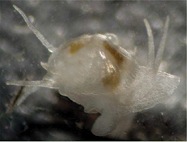| Waldo paucitentaculatus | |
|---|---|
 | |
| Shell | |
 | |
| Living animal | |
| Scientific classification | |
| Domain: | Eukaryota |
| Kingdom: | Animalia |
| Phylum: | Mollusca |
| Class: | Bivalvia |
| Order: | Galeommatida |
| Family: | Galeommatidae |
| Genus: | Waldo |
| Species: | W. paucitentaculatus |
| Binomial name | |
| Waldo paucitentaculatus Zelaya & Ituarte, 2013 | |
Waldo paucitentaculatus is a species of bivalve. [1] The species was described in 2013. It is known from the southwestern Atlantic in the Argentinean waters. It has been found living on the sea urchin Abatus cavernosus . [2]
A small species of Waldo, it can reach 2.2 mm (0.087 in) in length. The shell is extremely thin and slightly inequivalve. [2]